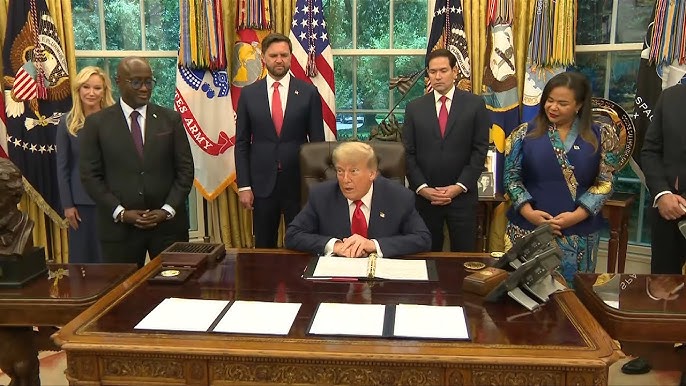
DRC, Rwanda take first step in implementing Washington peace deal » Capital News
NAIROBI, Kenya, Aug 1 – The Democratic Republic of the Congo (DRC) and Rwanda have convened the inaugural meeting of the Joint Oversight Committee (JOC) in Washington, D.C., marking a crucial first step toward implementing a landmark peace agreement signed on June 27.
In a joint statement, the US State Department said Thursday’s high-level meeting brought together representatives from both nations, alongside observers from the United States, the State of Qatar, the Republic of Togo — acting as the African Union (AU) facilitator — and the AU Commission.
“The Joint Oversight Committee is charged with serving as a forum for implementation and dispute resolution of the peace agreement,” the statement read in part.
The JOC will receive complaints of violations, take corrective measures, and resolve disputes through dialogue and consensus.
During the inaugural session, delegates from Kigali and Kinshasa appointed chairpersons, adopted terms of reference to guide future engagements, reviewed initial progress, and laid the groundwork for the upcoming session of the Joint Security Coordination Mechanism.
The discussions also sought to align the peace deal with wider stabilization initiatives across the Great Lakes region, ensuring synergy with ongoing regional and international diplomacy.
Both countries thanked the AU, the US, and Qatar for their support, describing their contributions as critical to fostering long-term peace and regional cooperation.
Nairobi meeting
On Friday, Zimbabwean President and SADC Chair Emmerson Mnangagwa met President William Ruto, who chairs the East African Community (EAC), for a Joint EAC-SADC Co-Chairs Meeting in Nairobi.
Kenya said the session was aimed at harmonizing peace efforts under the Nairobi and Luanda processes and aligning them with the Washington-brokered agreement.
“Our goal is to harmonize efforts and strengthen coordination between the Nairobi and Luanda processes to secure lasting peace and stability in eastern DRC,” said Foreign Affairs Cabinet Secretary Musalia Mudavadi.
He added that a strategic briefing session with the Panel of Facilitators was planned to “foster synergy between the two regional blocs.”
Trump to host Kagame, Tshisekedi
The two sessions precede a planned summit at the White House, where US President Donald Trump is expected to host Rwandan President Paul Kagame and Congolese President Félix Tshisekedi to finalize the June 27 peace deal — which Trump hailed as a “glorious triumph.”
Speaking from the Oval Office alongside Vice President J.D. Vance, Secretary of State Marco Rubio, and African delegates, Trump declared an end to destruction.
“Today, the violence and destruction come to an end, and the entire region begins a new chapter of hope and opportunity.”
The accord outlines the “disengagement, disarmament, and conditional integration” of armed groups operating in eastern DRC, a region long beset by conflict, armed militia activity, and regional rivalries.
Despite optimism in Washington and Nairobi, observers remain cautious.
Past peace efforts have repeatedly faltered due to deep-rooted mistrust, competing geopolitical interests, and the presence of numerous armed groups.
Rwanda’s alleged backing of the M23 rebel group — which has seized vast swathes of territory in North and South Kivu — remains one of the most contentious issues.
Kigali insists its estimated 7,000 troops in eastern DRC are there solely to contain the Democratic Forces for the Liberation of Rwanda (FDLR), a Hutu militia linked to the 1994 genocide.
Kinshasa, however, accuses Rwanda of using the FDLR threat as a pretext to expand its influence and exploit DRC’s vast mineral wealth — a claim Rwanda vehemently denies.
Disagreements have also emerged over the language of the peace deal. While Congolese officials say it calls for the withdrawal of Rwandan troops, Kigali maintains the final text deliberately uses the term disengagement to allow for phased and conditional implementation.
Fighting rages on
Even as high-level talks progress, fighting on the ground remains intense.
The M23 rebel group now controls significant areas of eastern DRC, including the strategic cities of Goma and Bukavu, displacing hundreds of thousands of civilians.
A July 3, 2025, letter from the UN Group of Experts to the Security Council reported that M23, in coordination with the Rwanda Defence Force (RDF), had captured vast mineral-rich territories in North and South Kivu. The report also noted that DRC continues to rely on proxy forces, including the Wazalendo militia and the FDLR.
“Although offensives carried out by AFC/M23 and RDF decimated the alliance of FARDC, Wazalendo, and FDLR, groups belonging to Wazalendo and FDLR reorganized and engaged in tit-for-tat attacks,” the experts wrote.
The renewed clashes have also hit international peacekeeping forces hard. According to UN and regional reports, three MONUSCO peacekeepers were killed and 37 injured, while 16 soldiers from the Southern African Development Community Mission in DRC (SAMIDRC) were killed and 26 wounded.
On July 12, Kagame hosted former Kenyan President Uhuru Kenyatta, a key facilitator in the DRC peace process under both the EAC and SADC frameworks, for talks in Kigali.
A statement from Rwanda’s presidency said the two leaders discussed “ongoing efforts to achieve durable peace in eastern DRC and address the root causes of the conflict.”
Whether these multi-layered initiatives — Washington-brokered, EAC-led, and SADC-supported — can overcome years of mutual suspicion and entrenched interests remains uncertain. But for a region that has endured decades of cyclical violence, the stakes could not be higher.